Pseuduvaria galeata is a species of plant in the family Annonaceae. It is a tree endemic to Peninsular Malaysia. James Sinclair, the Scottish botanist who first formally described the species, named it after the dome formed by inner petals shaped like a helmet.
Pseuduvaria taipingensis is a species of plant in the family Annonaceae. It is a tree endemic to Peninsular Malaysia. James Sinclair, the Scottish botanist who first formally described the species, named it after Taiping a city in Perak, Malaysia where the specimen he examined was collected.
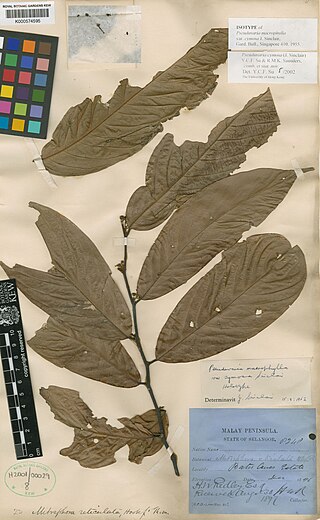
Pseuduvaria cymosa is a species of plant in the family Annonaceae. It is native to Peninsular Malaysia. James Sinclair, the Scottish botanist who first formally described the species using the synonym Pseuduvaria macrophylla var. cymosa, named it after its branched inflorescences which are called cymes.
Pseuduvaria glossopetala is a species of plant in the family Annonaceae. It is native to the Malay Peninsula. Yvonne Chuan Fang Su and Richard M.K. Saunders, the botanists who first formally described the species, named it after the tongue shaped gland on their inner petals.
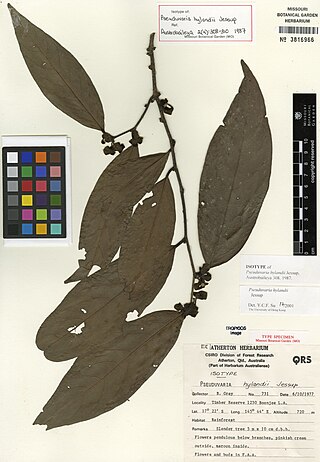
Pseuduvaria hylandii is a species of plant in the family Annonaceae. It is native to Australia. L.W. Jessup, the botanists who first formally described the species, named it after Bernard Hyland an Australian botanist who collected the specimen he examined.

Pseuduvaria luzonensis is a species of plant in the family Annonaceae. It is native to The Philippines. Elmer Drew Merrill, the American botanist who first formally described the species using the synonym Orophea luzoniensis, named it after Luzon in the Province of Battan, Philippines where the specimen he examined was collected along the Lamao River.
Pseuduvaria macgregorii is a species of plant in the family Annonaceae. It is native to The Philippines. Elmer Drew Merrill, the American botanist who first formally described the species, named it after Richard MacGregor the Australian ornithologist and plant collector who collected the specimen Merrill examined.
Pseuduvaria mindorensis is a species of plant in the family Annonaceae. It is native to the Philippines. Yvonne Su and Richard Saunders, the botanists who first formally described the species, named it after the island of Mindoro where the specimen they examined was collected in the municipality of Puerto Galera.
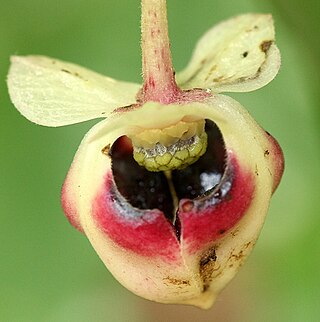
Pseuduvaria mulgraveana is a species of plant in the family Annonaceae. It is native to Australia. L.W. Jessup, the botanist who first formally described the species, named it after the Mulgrave River in Goldsborough, Queensland where the specimen he examined was collected.

Pseuduvaria guineensis is a species of plant in the family Annonaceae. It is native to New Guinea. James Sinclair, the Scottish botanist who first formally described the species, named it after New Guinea where the specimen he examined was collected near Kokoda.
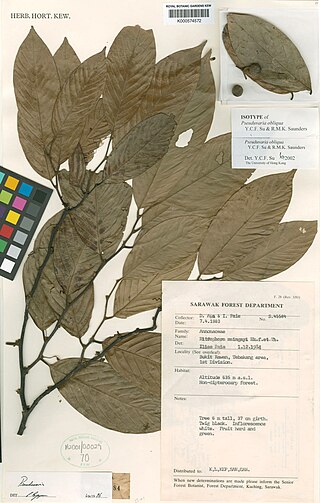
Pseuduvaria obliqua is a species of plant in the family Annonaceae. It is native to Borneo. Yvonne Su and Richard Saunders, the botanists who first formally described the species, named it after its slightly uneven leaf bases.
Pseuduvaria oxycarpa is a species of plant in the family Annonaceae. It is native to Sulawesi. Sijfert Hendrik Koorders, the Dutch botanist who first formally described the species, named it after the pointed tips of its fruit.

Pseuduvaria pamattonis is a species of plant in the family Annonaceae. It is native to Borneo and the Philippines. Friedrich Miquel, the Dutch botanist who first formally described the species using the basionym Orophea pamattonis, named it after a mountain in Borneo called Gunung Pamaton.
Pseuduvaria parvipetala is a species of plant in the family Annonaceae. It is native to Borneo and Sumatra. Yvonne Su and Richard Saunders, the botanists who first formally described the species, named it after its small petals.
Pseuduvaria pulchella is a species of plant in the family Annonaceae. It is native to New Guinea. Ludwig Diels, the botanist who first formally described the species using the basionym Orophea pulchella, chose a specific epithet that means “beautiful little” in Latin, but he did not specify to which aspect of the plant he was referring.

Pseuduvaria reticulata is a species of plant in the family Annonaceae. It is native to Bangladesh, Borneo, Java, the Lesser Sunda Islands, Myanmar and Sumatra. Carl Ludwig Blume, the botanist who first formally described the species under the basionym Uvaria reticulata, named it after the net-like pattern of veins on the underside of its leaves.

Pseuduvaria rugosa is a species of plant in the family Annonaceae. It is native to Java, Laos, the Lesser Sunda Islands, Peninsular Malaysia, Myanmar, the Nicobar Islands, Sumatra and Thailand. Carl Ludwig Blume, the botanist who first formally described the species under the basionym Uvaria rugosa, named it after its wrinkled fruit.
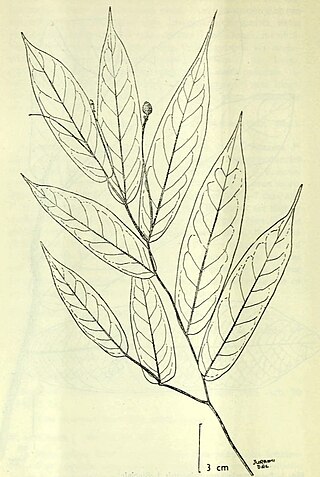
Pseuduvaria sessilifolia is a species of plant in the family Annonaceae. It is native to New Guinea. James Sinclair, the botanist who first formally described the species, named it after its stalkless leaves which lack petioles.
Pseuduvaria silvestris is a species of plant in the family Annonaceae. It is native to New Guinea. Ludwig Diels, the botanist who first formally described the species under the basionym Orophea silvestris, named it after the forested habitat the specimens he examined were found growing in near the Waria River.
Pseuduvaria trimera is a species of plant in the family Annonaceae. It is native to China, Myanmar, Thailand, and Vietnam. William Grant Craib, the British botanist who first formally described the species, named it after its fascicles of flowers that often occur in three parts.










